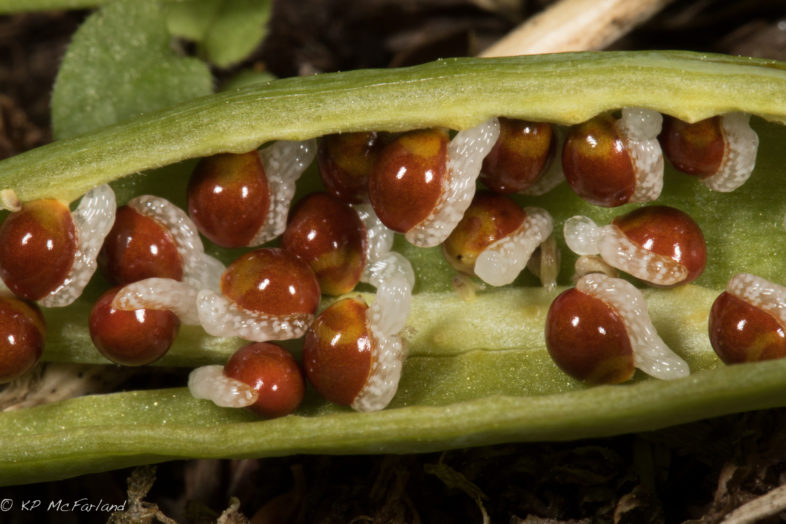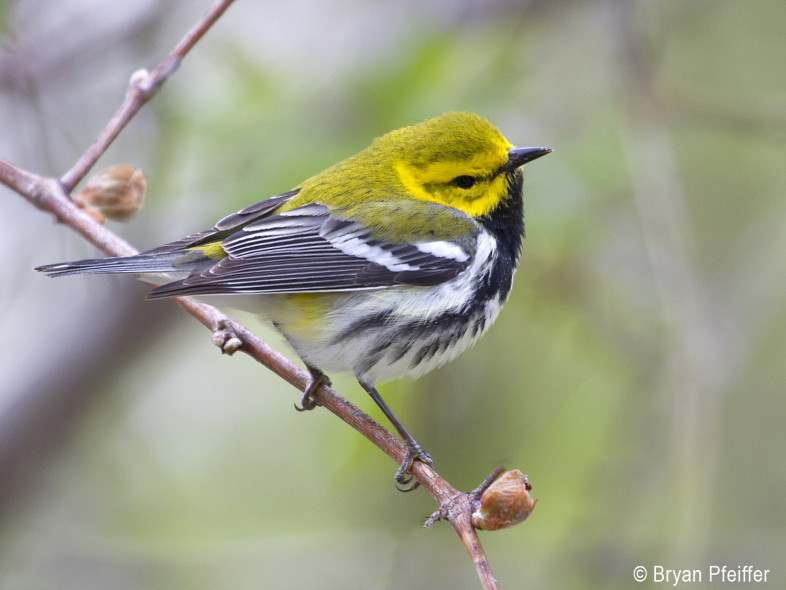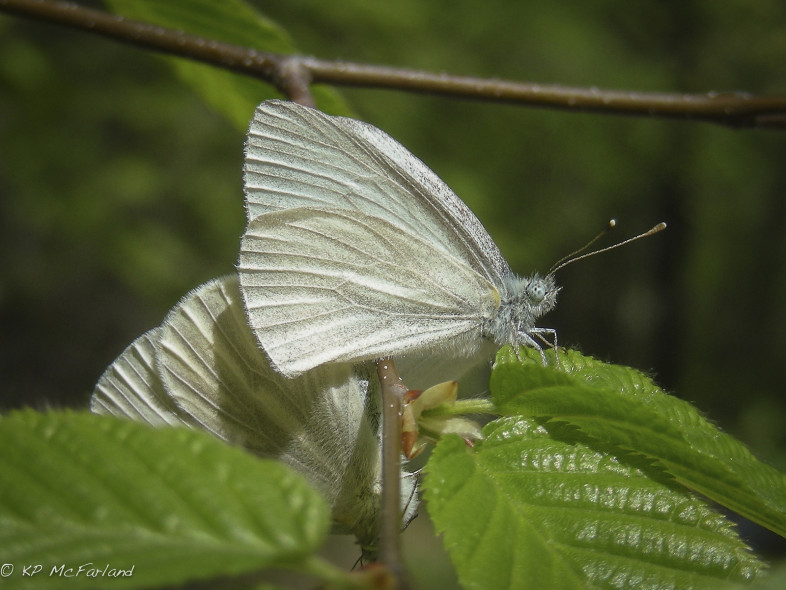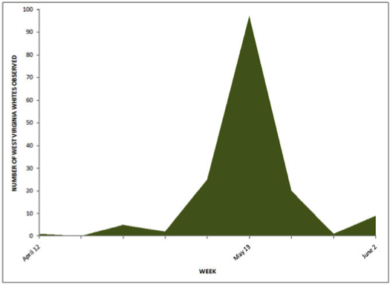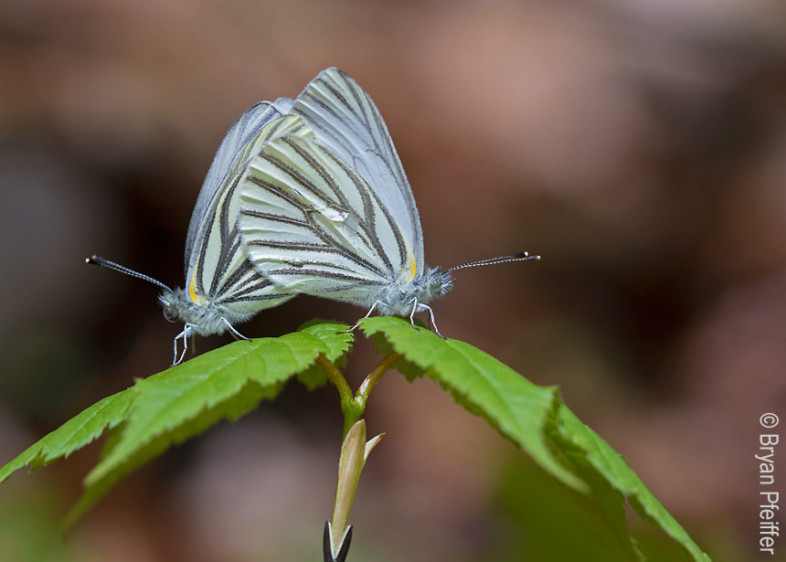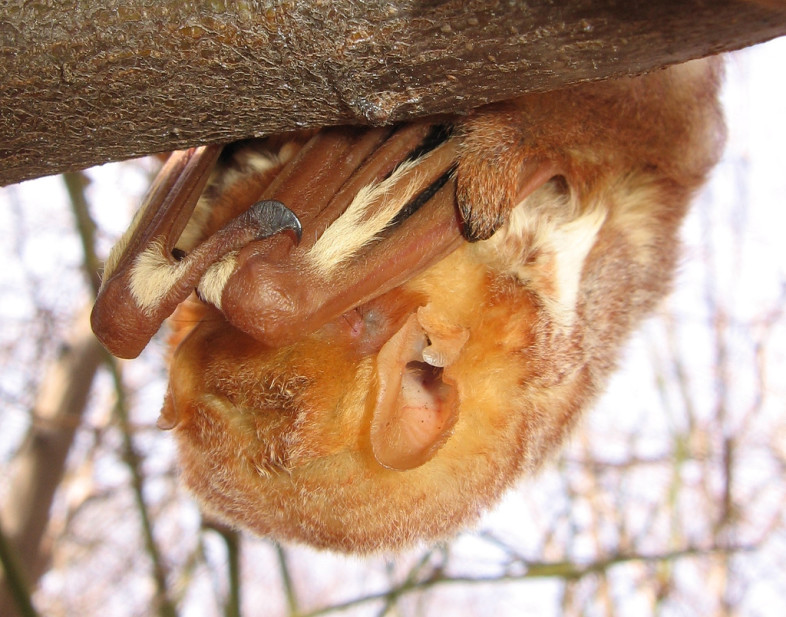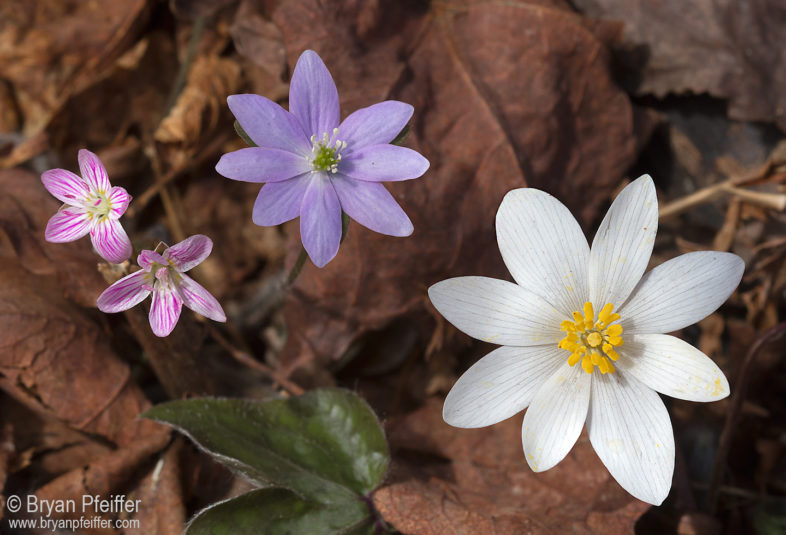
It’s always great to see these spring ephemeral wildflowers after a long winter, but to find all three together in one little patch…ecstasy. (Left to right: Carolina Spring Beauty, Sharp-lobed Hepatica and Bloodroot) / © Bryan Pfeiffer
The month of May is a show-off. Grass glows green under blue skies. Woodland wildflowers break out of the ground and demand attention. Trees flower and leaves burst from long-dormant buds. Songbirds arrive on southern night winds and liven the dawn with a chorus of song. May shouts of life and rejuvenation. Here’s a few bits of natural history for your May days.
Spring Ephemeral Woodland Wildflowers
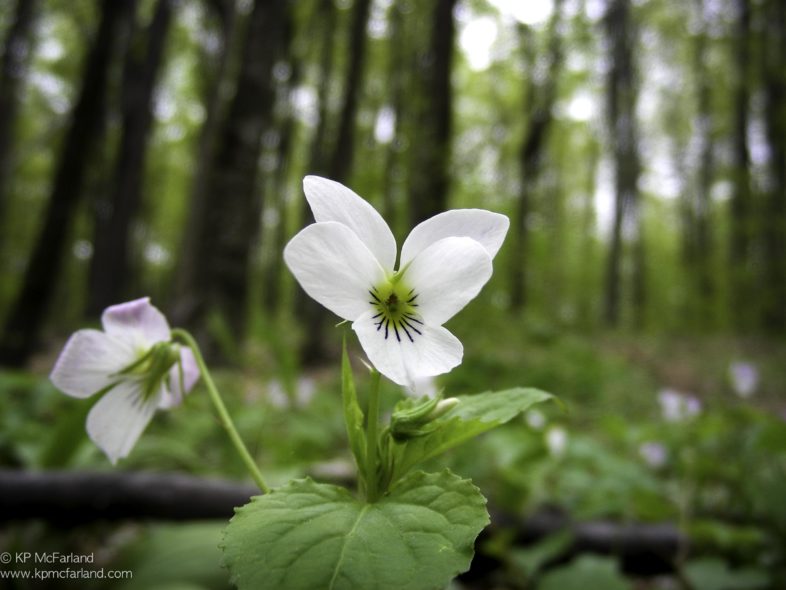
Canada Violet (Viola canadensis) flowers below the trees before they fully leaf out. / © K.P. McFarland
Spring ephemeral wildflowers are perennial woodland plants that sprout from the ground early, bloom fast and then go to seed — all before the canopy trees overhead leaf out. Often found in calcium-rich woods, these “ephemerals” include Spring Beauty, Dutchman’s Breeches, Blue Cohosh, Hepatica, Wild Ginger and a few others. Once the forest floor is deep in shade, the plant’s leaves wither away leaving only the roots, rhizomes and bulbs underground. It allows the plants to take advantage of the full sunlight levels reaching the forest floor during a short time in early spring.
Many of these plants rely on myrmecochory — seed dispersal by ants. The seeds of spring ephemerals bear fatty external appendages called eliaosomes. Ants harvest and carry them back to their nests and eat them. The unharmed seeds are thrown into the trash bin and eventually germinate. A single ant colony may collect as many as a thousand seeds over a season. Unlike seeds dispersed by birds or wind, on average, a seed is only carried about two meters from the parent plant. With such short distance dispersal, forest fragmentation is a threat to the survival of spring ephemerals. Once these plants are gone from the forest, it is rare that they return.
Long-term flowering records initiated by Henry David Thoreau in 1852 have been used in Massachusetts to monitor phenological changes. Phenology — the study of the timing of natural events such as migration, flowering, leaf-out or breeding — is key to examine and unravel the effects of climate change on ecosystems. Record-breaking spring temperatures in 2010 and 2012 resulted in the earliest flowering times in recorded history for dozens of spring-flowering plants of the eastern United States.

Bloodroot phenology from iNaturalist Vermont. flowering (blue), seeding (orange), and stage not noted (gray). Add your observations too!
Be like Thoreau. Help us monitor wildflower phenology. Find an area to monitor in a forest near you or simply record the status of those plants you find. You can enter your observations on our site at iNaturalist Vermont. Please include a photograph(s) of the plant.
Some Fabulous Spring Wildflowers (click to see field guide at iNaturalist Vermont and search for more):
Trout Lily (Erythronium americanum)
Bloodroot (Sanguinaria canadensis)
Marsh Marigold (Caltha palustris)
Carolina Spring Beauty (Claytonia caroliniana)
Red Trillium (Trillium erectum)
Painted Trillium (Trillium undulatum)
Starflower (Trientalis borealis)
Dutchman’s Breeches (Dicentra cucullaria)
Squirrel Corn (Dicentra canadensis)
Jack-in-the-pulpit (Arisaema triphyllum)
Canada Violet (Viola canadensis)
Wild Ginger (Asarum canadense)
Sharp-lobed Hepatica (Anemone acutiloba)
Early Blue Cohosh (Caulophyllum giganteum) and Blue Cohosh (Caulophyllum thalictroides)
A SWIFT RETURN
There is nothing that says spring more than the chattering of Chimney Swifts over town. The swifts circle back and forth picking out the best chimneys for roosting and nesting. Before European settlement, they likely used giant hollow trees in the forest or shallow caves; some may still. But with the loss of big snags in the forest and the construction of chimneys in the towns and cities, Chimney Swifts transitioned from being country to city dwellers.
Chimney Swifts are perhaps the most aerial of any land bird, only landing when at the nest or roosting at night. They even bathe in flight by skimming the surface with their breast feathers, shaking off water as they fly upward. They do everything in flight, eating, drinking, preening, and even apparently copulating. Their long, sleek wings — much longer than their bodies — help keep them aloft with a minimum of energy.

Frequency of Vermont eBird checklists reporting Chimney Swifts each week from 2013 to 2017. Click on the chart to view on Vermont eBird to change dates and locations for the chart.
Swifts don’t perch like similar-appearing swallows do. You will never see them sitting on an electric or fence line. They have very short legs and long claws to cling to walls of chimneys and other vertical surfaces. The also have tail feathers with long stiff shafts to rest against a wall as they cling, much like woodpeckers (see image above).
They are gregarious during the non-breeding season. On migration some old factory stacks may hold thousands of roosting swifts, making these old structures potentially important migratory stop-over sites for the birds on their travels back and forth to their South American wintering grounds.Recent changes to chimney designs such as narrow flues and liners, spark arresters and covers, or the outright loss of old chimneys have decreased available nest sites for swifts and may be a factor in their declining populations. Populations have dropped by nearly 50% in many places throughout the species’ range. Only one pair of Chimney Swifts will nest in each available chimney.
It has been estimated that two parents and their nestlings will consume about 12,000 flying insects every day. Take a walk around your town some evening after dinner to watch the aerial acrobats at work and hear their industrious twittering.
The Dawn Chorus Begins
From the seemingly simple trill of a Swamp Sparrow to the mimicry of the Northern Mockingbird, a songbird’s ability to learn is music to our ears. As Miss Maudie said in To Kill a Mockingbird, “‘Mockingbirds don’t do one thing but make music for us to enjoy. They don’t eat up people’s gardens, don’t nest in corncribs, they don’t do one thing but sing their hearts out for us.’” The choir begins to warm up in early May and by the end of the month a full concert is conducted each morning.
This is when birders are most delighted. They can’t help themselves. They’re calling out each species as they hear the song, sometimes to themselves just to acknowledge the wonder, other times to people around them that might not be noticing the fine vocals. Bird watching by ear is a craft that takes years of practice.
Here’s six tips to help you learn to bird by ear:
- Learn to listen. Stand and listen to each and every bird song you can hear. Learn to just pick them out first. Just notice them.
- Master the bird songs in your yard first.
- Associate songs with something memorable: ‘Drink your teeeeaaa” is what the Eastern Towhee says. Black-capped Chickadees call out, ‘cheeese burger.’
- Track the singing bird down and identify it visually.
- Go birding with experienced birders. Don’t be afraid to ask them lots of questions. Most love to pass on knowledge.
- Record them with your smartphone or other device and identify them and study them at home later. Before you know it, you’ll have them in your song book.
- eBird and the Macaulay Library have a fun new tool: the eBird photo + sound quiz. Quiz yourself on 20 images or sounds from birds anywhere in the world, all based on media uploaded by eBirders everywhere. Warning: your spare time may never be the same.
- Check out all the awesome recordings by birdwatchers on Vermont eBird and add your own.
- Be patient. It takes years to learn them all, but it is worth it!
EGGS AND ALGAE
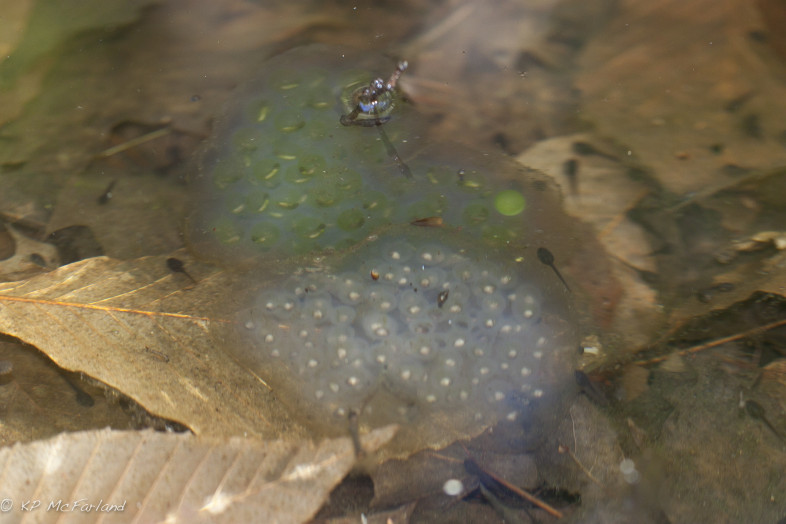
Egg masses with and without algae. / © K.P. McFarland
Peer into a woodland vernal pool in New England right now and you’re liable to find masses of developing Spotted Salamander eggs. Many of them have a green hue visible throughout the gelatinous mass. Most things lying in water eventually get coated in algae. But in 1927 Lambert Printz realized this was a special green algae only found on these eggs and formally named named it Oophilia, meaning egg loving, amblystomatis, from the genus name for spotted salamanders.
In the 1980’s biologists wondered if perhaps there was more to the relationship between algae and animal. They found that spotted salamander embryos grown without green algae didn’t develop as quickly. It was thought that the algae perhaps provided more oxygen for eggs in potentially oxygen-poor waters.
However, biologists recently reported in the Proceedings of the National Academy of Science that they discovered green algae actually living inside the cells of developing spotted salamander embryos. In an Indiana University press release biologist Roger Hangarter said, “With the ability to use gene-specific probes, it is now possible to determine the presence of organisms that may not be easily visible by standard light microscopy. In the past, researchers looking with simpler light microscopy techniques than are available today failed to see any algae in the salamanders.”
This special symbiotic relationship is termed endosymbiosis, in which two species not only share living space with each other, but one actually lives inside the cells of another. They found evidence of green algae in salamander oviducts suggesting that transmission may occur from one salamander generation to the next via transmission through eggs.
Learn more about vernal pools on the VCE web site.
A Freeze Before There Are Leaves
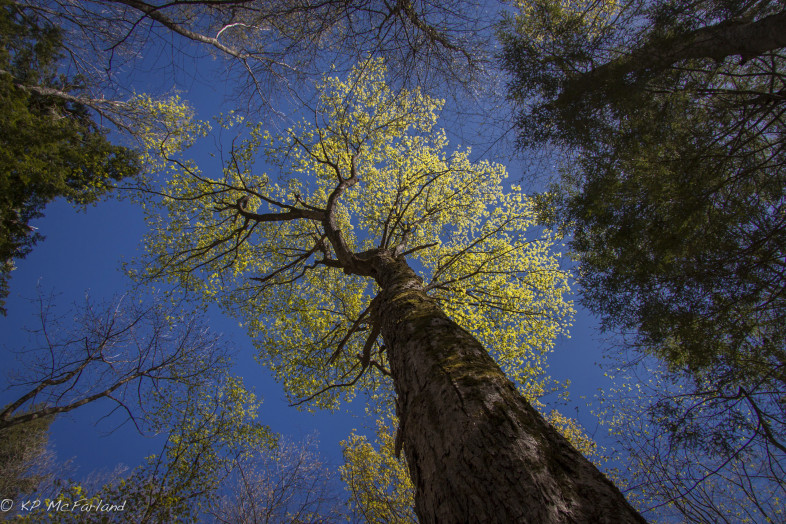
Sugar Maple leaves beginning to open. /© K.P. McFarland
The trees in the northern hardwood forest have to be exposed to a long freeze period before warm air arrives to force the leaves to break out of the buds. We’re pretty sure they had enough of that this year! Like fine beverages, the exact temperatures and duration of chill needed to break dormancy vary by tree species and geography. Some may need just a few weeks of chilling, while others may require months. Sugar Maple needs about 2,000 hours of freezing temperatures. Red Maples need a few months here in the north, but in Florida, they may not need to be chilled at all for leaf out to happen.
SPRING EPHEMERAL BUTTERFLIES
It’s not a gaudy butterfly. It isn’t the biggest or the smallest. In fact, it’s mostly just white. But this butterfly is unusual; it only flies in forests. Its an ephemeral spring wildflower groupie.
To see this butterfly you need to get to rich, mature hardwoods with spring wildflowers early in the season. Our other, more common veined white, the Mustard White, does fly in woods, but it has distinct dark veins in its first brood (when it may be confused with West Virginia White). The West Virginia White always has faint gray scaling along the veins. And, unlike the Mustard White, it only flies early in the season. Their flight is slow and close to the ground. Follow a woodland stream until you find the host plant, — and the butterfly. It’s caterpillars only feed on Crinkleroot (Cardamine diphylla) and Cut-leaved Toothwort (Cardamine concatenata).
But there’s a dirty player in the field – introduced Garlic Mustard (Alliaria petiolata). Garlic mustard was first found in the United States about 1868 on Long Island. Invasions of Garlic Mustard are causing local extirpations of toothwort, and chemicals in Garlic Mustard appear to be toxic to West Virginia Whites, yet the adults are attracted to it and lay eggs on it.
Here’s a pair of spring form Mustard Whites, their close cousin, below for comparison. Add all of your butterfly sightings to eButterfly!
RED BATS ARRIVE
Eastern Red Bats arrive back in northern New England from the south in May, although little is known about their migration routes or overwintering range. They are strong fliers and are sometimes seen migrating during the day. There have even been reports of the species far offshore during migration. One individual was found 65 miles off the New England coast.
Eastern Red Bats vary in color from brick red to buffy orange. The hairs of the back are tipped with white. Males tend to be less frosted with white than females, but are brighter in color. Both sexes have a buffy-white shoulder patch.
Once here, Eastern Red Bats roost by day 30-40 feet high in the foliage of deciduous trees. They select perches that are open from below to permit easy access, but otherwise densely shaded to hide from predators. They hang by one or both feet and resemble a dead leaf.
Eastern Red Bats breed in August and September, but fertilization doesn’t occur until nearly 8 months later in spring. A litter of 1 to 5 young is born in June or early July, the largest litter size of any bat. Young remain at the roost while their mother forages. Adults feed on many different types of flying insects, but beetles and moths comprise about 50% of their diet. When the mother returns to the roost, the young grasp her with their wings and teeth to nurse. Nursing occurs over about 1-2 months, and until the young become independent and disperse.
